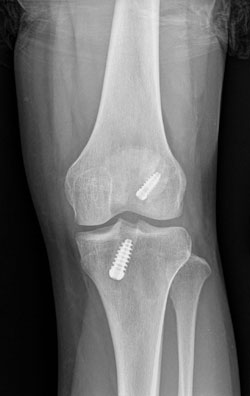Fewer ACL failures with autograft vs. allograft for young athletes
ACL reconstruction using allograft in young patients more often results in the need for revision than procedures using autograft, according to a recently presented study.
“Some studies have suggested that failure with allograft is equal to that of autograft, but these studies did not stratify the results by age and activity level,” Brett D. Owens, MD, said during his presentation at the 2011 Annual Meeting of the American Orthopaedic Society for Sports Medicine. “Clearly, this creates concerns for young athletes.”
Military academy cohort
Owens and colleagues conducted a prospective cohort study of military academy cadets with a mean age of 19 years from the classes of 2007 through 2013 who underwent ACL reconstruction before entering the academy. Patients were evaluated upon enrollment with physical examination and type of graft used.
|
Image: Owens BD |
“All subsequent injuries were tracked with an epidemiologic injury tracking system as well as athletic participation’s mandatory and required medical excuses,” Owens said. “We did not have any subjects that were medically discharged from the military due to their knee condition. Therefore, failure was defined as the requirement for revision reconstruction.”
Owens and his team tracked patients from time enrolled to revision failure or until they were lost to surveillance.
There were 122 patients with complete data available and most of the patients were male. The cohort included 61 bone-tendon-bone autografts, 45 hamstring autografts and 16 allografts reconstructions.
Failure rates
The investigators found 20 failures. Of the failures requiring revision, 7 or 11% were bone-tendon-bone autograft reconstructions, 6 or 13% were hamstring autograft and 7 or 44% were allograft procedures. Use of an allograft rather than autograft lead to a significantly higher failure rate, Owens said.
Limitations of the study included multiple surgeons performing the surgeries and different techniques, tunnel positions, graft fixations, implants and rehabilitation protocols. The type of graft sterilization for each allograft was unknown. The team did not look at patients’ radiographs.
“We recommend the use of autologous grafts in young athletes.” Owens said. – by Renee Blisard
Reference:Pallis MP, Svoboda SJ, Cameron KL, Owens BD. Survival comparison of allograft and autograft ACL reconstruction at US military academy. Paper #3. Presented at the 2011 Annual Meeting of the American Orthopaedic Society for Sports Medicine. July 7-10. San Diego.

Brett D. Owens, MD, can be reached at Keller Army Hospital, 900 Washington Rd., West Point, NY 10996-1197; 845-938-4034; email: b.owens@us.army.mil.
Disclosure: Owens has no relevant financial disclosures.


